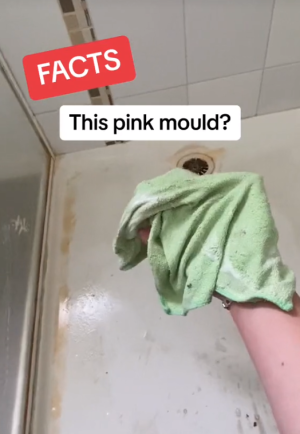Professional cleaner exposes shocking dangers of pink 'mould' in your shower!
By
- Replies 8
When it comes to maintaining a clean and healthy home, the bathroom is often a focal point for our efforts.
It's a place where hygiene is paramount, and yet, it's also a breeding ground for various types of bacteria and mould.
One such concern that has been brought to light by an Australian cleaner is the presence of a pink residue commonly mistaken for mould.
According to Kacie Stephens, founder of The Big Clean Co cleaning company, this pink 'mould' is not mould at all, but a potentially harmful bacteria that could pose serious health risks if not addressed promptly.
'The build up of it on your shower can cause infections, so make sure you're washing it away regularly,' she warns.
The pink residue is actually a bacteria known as Serratia marcescens. This bacteria thrives in warm, humid environments and feeds off fatty deposits such as soap residue.
It's a common sight in bathrooms, particularly in showers, where it can build up over time.
While it may seem harmless, Serratia marcescens can cause significant health problems if ingested, exposed to an open wound, or encountered by those with compromised immune systems.
While Serratia marcescens is often harmless to those who come in contact with it, it can cause major problems under certain circumstances if ingested, if exposed to open wounds, and if you have a weak immune system.
The good news is that Serratia marcescens can be easily removed with regular cleaning.
A simple wipe with dishwashing liquid and bicarb soda, or bleach, can effectively eliminate the bacteria.
It's crucial to clean away the pink residue as soon as it's identified to reduce the risk of any adverse health effects.
Stephens' warning about the pink 'mould' has caught the attention of people on social media, many of whom were shocked by the revelation.
Some thought the pink residue came from other sources like body fat and rusty water pipes, while others admitted to blaming their partners for the unsightly build-up.
'I thought it was pee and blamed my boyfriend for peeing in the shower,' one viewer confessed.
'I always wondered what it was,' another said.
Others shared their own tricks for getting rid of the pesky build-up.
'Cillit Bang Power Cleaner Black Mould Remover. Spray on, leave for 15 minutes and shower or wipe away. Better than bleach,' one user suggested.
'Acid-based cleaner every time to get rid of this,' another chimed in.
This revelation underscores the importance of regular cleaning, particularly in areas like the bathroom that are prone to bacterial growth.
Regular cleaning not only keeps your home looking its best, but it also helps to protect your health and the health of your loved ones.
So, the next time you see that pink 'mould' in your shower, remember: it's not just an eyesore, it's a potential health hazard.
Regular cleaning is the best way to keep Serratia marcescens at bay and ensure your bathroom is a safe, hygienic space.
You can watch Stephens’ full video below:

Have you encountered this pink 'mould' in your bathroom? Share your experiences and cleaning tips in the comments below.
It's a place where hygiene is paramount, and yet, it's also a breeding ground for various types of bacteria and mould.
One such concern that has been brought to light by an Australian cleaner is the presence of a pink residue commonly mistaken for mould.
According to Kacie Stephens, founder of The Big Clean Co cleaning company, this pink 'mould' is not mould at all, but a potentially harmful bacteria that could pose serious health risks if not addressed promptly.
'The build up of it on your shower can cause infections, so make sure you're washing it away regularly,' she warns.
The pink residue is actually a bacteria known as Serratia marcescens. This bacteria thrives in warm, humid environments and feeds off fatty deposits such as soap residue.
It's a common sight in bathrooms, particularly in showers, where it can build up over time.
While it may seem harmless, Serratia marcescens can cause significant health problems if ingested, exposed to an open wound, or encountered by those with compromised immune systems.
While Serratia marcescens is often harmless to those who come in contact with it, it can cause major problems under certain circumstances if ingested, if exposed to open wounds, and if you have a weak immune system.
The good news is that Serratia marcescens can be easily removed with regular cleaning.
A simple wipe with dishwashing liquid and bicarb soda, or bleach, can effectively eliminate the bacteria.
It's crucial to clean away the pink residue as soon as it's identified to reduce the risk of any adverse health effects.
Stephens' warning about the pink 'mould' has caught the attention of people on social media, many of whom were shocked by the revelation.
Some thought the pink residue came from other sources like body fat and rusty water pipes, while others admitted to blaming their partners for the unsightly build-up.
'I thought it was pee and blamed my boyfriend for peeing in the shower,' one viewer confessed.
'I always wondered what it was,' another said.
Others shared their own tricks for getting rid of the pesky build-up.
'Cillit Bang Power Cleaner Black Mould Remover. Spray on, leave for 15 minutes and shower or wipe away. Better than bleach,' one user suggested.
'Acid-based cleaner every time to get rid of this,' another chimed in.
This revelation underscores the importance of regular cleaning, particularly in areas like the bathroom that are prone to bacterial growth.
Regular cleaning not only keeps your home looking its best, but it also helps to protect your health and the health of your loved ones.
So, the next time you see that pink 'mould' in your shower, remember: it's not just an eyesore, it's a potential health hazard.
Regular cleaning is the best way to keep Serratia marcescens at bay and ensure your bathroom is a safe, hygienic space.
You can watch Stephens’ full video below:
Key Takeaways
- An Australian cleaner has warned about the potential dangers of pink residue, often mistaken for mould, in bathrooms.
- The pink substance is actually a bacteria known as Serratia marcescens, which can cause infections and should be cleaned away regularly.
- Serratia marcescens thrives in damp environments and feeds on soap residue, posing a risk particularly to those with compromised immune systems if ingested or if it enters an open wound.
- The cleaner shared tips for removing the pink bacteria, suggesting the use of dishwashing liquid and bicarb soda, bleach, or specialised mould removal products.
Have you encountered this pink 'mould' in your bathroom? Share your experiences and cleaning tips in the comments below.








